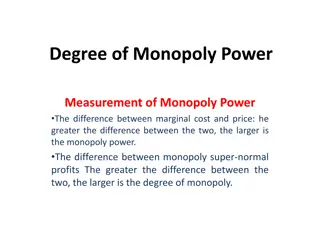Understanding Utility: Marginal vs. Total Utility
Utility in economics is the satisfaction derived from consuming goods or services. Marginal utility measures the change in total utility as consumption increases, whereas total utility is the sum of satisfaction obtained from consuming different units of a commodity. Consumers aim to maximize total utility by strategically allocating their income. The relationship between total utility and marginal utility can be seen in how each subsequent unit affects satisfaction levels.
Download Presentation

Please find below an Image/Link to download the presentation.
The content on the website is provided AS IS for your information and personal use only. It may not be sold, licensed, or shared on other websites without obtaining consent from the author. Download presentation by click this link. If you encounter any issues during the download, it is possible that the publisher has removed the file from their server.
E N D
Presentation Transcript
INTRODUCTION The term utility refers to the quality of a commodity by virtue of which it satisfy our wants. In other words, want satisfying power of a good is called utility. It measures in terms of utils or units of utility. It is the pleasure or satisfaction (value of money) derived by a person from the consumption of a good or service or from being in a particular place and for the maximisation of which all economic action are motivated. It cannot be measured in objective terms. Utility has two main form: (i) Marginal Utility, (ii) Total utility. Pro. Alfread Marshal in his book Principles of Economics 1890 has given the detailed concept of utility. In general we can describe that Utility means total satisfaction received from consuming a good or services . Utility is measurable in term of money.
MARGINAL UTILITY Marginal utility refers to the change in total utility, which results from a unit increase in a consumption. With the increase in the units of consumption Total utility increases but it s not necessary that marginal utility also increases. It differs from the concept of total utility. It may be Positive, Negative or Zero MU= TUn TUn-1 ?? ????? ??????? ?????? ?? ????????? or MU= Here, MU = Marginal Utility TUn = Total Utility of n units of commodity TUn-1= Total Utility of n-1 units of commodity
Example: Suppose a person get utility from the one unit of consumption is 10 utils and utility from the use of second unit of consumption is 15 utils. So, here Marginal utility for first unit is 10 units/utils and for second unit Marginal Utility is 5 units/utils. here, MU= TUn TUn-1 = 15-10 =05
TOTAL UTILITY It refers to the sum of marginal utilities obtained from the consumption of different units of commodity. Customers spent their income in a systematic way so that they can get maximum satisfaction. Thus, customers use various goods and services to meet their needs with the use of this commodities they get satisfaction and total of this satisfaction is known as Total Utility. Customers spend every part of their income in such a way that they can get maximum satisfaction/utility. In a same way total of utility derived from the use of more than one unit of same commodity is also known as Total Utility i.e. Total of utility derived from the consumption of first unit Chocolate and utility from second unit of chocolate is known as Total Utility. Consumer always want to maximise their Total Utility.
RELATIONSHIP BETWEEN TOTAL UTILITY & MARGINAL UTILITY Relationship between Marginal Utility and Total Utility can be explained with the help of following diagram: Units of Commodity Total Utility (TU) Marginal Utility (MU) 1 25 25 2 47 22 3 66 19 4 76 10 5 80 04 6 80 00 7 75 -05 8 68 -07
Total utility Marginal Utility 90 80 80 76 80 75 68 66 70 TU 60 47 50 40 UTILITY 30 25 25 22 19 20 10 10 4 0 0 -5 7 -7 8 1 2 3 4 5 6 -10 MU -20 COMMODITY
From the above diagram it can be obtained that: When MU is Positive, TU Increases When MU is Zero, TU is Maximum When MU is Negative, TU begins to fall MU (+) TU MU (0) TU Max. MU (-) TU Marginal Utility can be positive, Negative or Zero. But Total Utility is always Positive. At the beginning TU increases then after reaching its maximum point it starts to decline.
LAW OF DIMINISHING RETURN This law states that marginal utility tends to decline as more and more units of commodity are consumed by a consumer, the intensity of desire for a commodity tends to decrease. This is called law of diminishing marginal utility. It is also called Fundamental Law of Satisfaction or Fundamental Psychological Law . Basic Assumptions of this law are; Only standard units of the commodity are consumed. Like a cup of tea not its spoon. Consumption of the commodity should be continuous. Commodity should be of same nature Law of diminishing return can be best explain with the following Table;
Law of diminishing return can be best explain with the following Example; Units of Commodity (Chocolate) 1 Marginal Utility (MU) Here in this table Marginal Utility (MU) tends to diminish as consumption increases. It is important to note that as more and more units of Chocolate are consumed by the consumer, marginal Utility (MU) tends to diminish. When consumer consumes 6thunits of Chocolate MU will become Zero (0) and after that at the consumption of 7thunit of Chocolate, MU become Negative 25 2 22 3 19 4 10 5 04 6 00 7 -05 8 -07
30 25 25 22 19 20 15 Utility 10 10 4 5 0 0 1 2 3 4 5 6 7 8 -5 -5 -7 MU -10 Commodity























